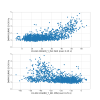Earlier today I did some 2.6 Hz sine injection in DHARD_Y (71590) to understand the upconversion phenomenon seen previously (71505). This is maybe related to the non-stationary noise in the 20-50 Hz (71092) and the observed bicoherence (71005).
In summary: DARM noise between 20 and 80 Hz gets worse for positive excursions of DHARD_Y_IN1 from zero, but not for negative excursions.
It doesn't look like it is necessaarily correlated with the 2.6 Hz peak (although that peak contains a lot of the RMS in normal conditions).
This might indicate that we have a static offset in DHARD_Y alignment.
The first atttached spectrogram shows in the top panel a DARM spectrogram, whitened to the median of a quiet time, so that a value of 1 means normal noise levels. The bottom panel shows the DHARD_Y 2.6 Hz excitation amplitude, and the DHARD_Y error signal value. The most interesting feature is that noise in DARM is higher when DHARD_Y value is positive and large, but not when it is large and negative. The second plot shows a zoom in time of the same spectrogram, which makes the correlation evident.
To better understand, I computed the DARM BLRMS in the 20 to 50 Hz region [using the spectrogram, averaged over 2-s-long windows with 1-s overlap] , and compared it with the maximum value of DHARD_Y [in the corresponding 1-s window]. The third plot shows the corrrelation and the fourth plot is a time zoom showing the clear correlation with the positive peak value of DHARD_Y.
There is a clear correlation between the DARM BLRMS between 20 and 50 Hz and the maximum positive value of DHARD_Y_IN1, but not the maximum negative value. The last plot shows how the BLRMS is correlated with large positive excursions of DHARD_Y.
Possible causes for this behavior:
- do we have a large static misalignment of DHARD_Y (maybe also consistent with the large ITMY A2L needed to reduce the coupling to DARM 71588)
- are we clipping somewhere in the output path, so when the beam moves on one side we have more noise?
- are we saturating some actuators?
- suggested by Daniel: a scattering path that depends on one of the test mass aligments
Some next useful tests:
- repeat the test at a diffferent driving frequency, to confirm it's not necessarily related to 2.6 Hz but to the signal excursion from zero
- add offsets to DHARD_Y to see if they improve th DARM noise, and while injecting a line to see if they fix the observed behavior
As a side note, the RMS of DHARD_Y is dominated by a 1.3 Hz and a 2.6 Hz peaks. The 2.6 Hz peak could be the high frequency plant resonance, but the lowest plant resonance is at 1.05 Hz (71489). Previously I showed that there is some evvidence that the test mass M0 damping could be responsible for most of the DHARD_Y motion below a few Hz (71466). So maybe another useful test would be to check the status of the test mass M0 damping, and do some noise injections to properly project the OSEM noise contribution to DHARD_Y
On Saturday, while damping violin modes, I repeated this test, adding an offset to the DHARD_Y error point. The results are different than before: it looks like DARM is more noisy for negative excursions of the error signal from zero, instead of positive excursions as observed before. It appears that adding an offset that makes the error signal positive reduces the non-stationary noise in DARM.
It's not clear to me why this behavior is now different. Two ideas: 1) there are ASC error point offsets that change from lock to lock 2) this test was performed while dampiing violin modes, with a IFO still warming up, while the previous test was with a thermalized IFO





